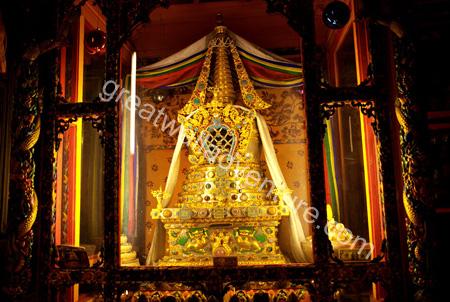|
|
Lhasa Tour of
Ganden Monastery
|
|
Ganden Monastery is located on Wangbur Mountain, on the
southern bank of Lhasa River in Tagtse County, 47 kilometers (29
miles) from Lhasa City. It stands at an altitude of 3,800 meters
(12,467 feet) above sea level! Ganden Monastery is one of the
earliest and largest Buddhist monasteries in Tibet, and stands atop
of the six famous temples of Gelugpa - a branch of Tibetan Buddhism.
Its significance as a religious, artistic, political and cultural
relic led to it being preserved by the National Key Cultural Relic
Preservation scheme in 1961, and is now known as being one of the
'Three Great Temples', together with the Sera Monastery and the
Drepung Monastery . Every year, one of the grandest of Buddhist
activities - Buddha Painting Unfolding Festival - is conducted in
the monastery, attracting thousands of visitors and disciples.
In the early 15th century, Tsong Khapa called for the
Reformation of Religion, advocating the rooting out the previous
disadvantages in religious orders and initiated the Gelugpa. This
sect also became known as the Yellow Hat sect, as its disciples were
always wearing yellow hats. This order went on to become the biggest
sect in Tibetan Buddhism, leading to Tsong Khapa establish the
Ganden Monastery. Since dharma is essential to the teachings of the
sect, the whole layout of the monastery is built on its principles.
The temple is comprised of over 50 structures. The main
halls in the temple are the Main Assembly Hall (or Coqen Hall),
Zhacangs, Khangtsens, and Myicuns.
Coqen Hall is positioned in the northern part of the
whole complex and faces south. It serves as the main assembly hall.
It has three levels, and is 43.8 meters (143.7 feet) wide and 44.7
meters (146.7 feet) long. The Sutra Hall runs through the middle of
the first floor, with the three Buddha Halls branching from it. The
Sutra Hall is so large that it can hold over 3,000 lamas. Inside the
Buddha Halls are statues of the Maitreya Buddha and the master Tsong
Khapa, the initiator of Gelugpa. To the west of Coqen Hall is the
other main hall consisting of the Buddhist Guardian Hall, Mandala
Hall, and other complexes. It was built during the early fifteenth
century, from 1409 - 1416. Built into its back wall is a huge stone
which is said to have flown from India!
Tri Thok Khang is one of the earliest Buddha Halls in
the Ganden Monastery, and once served as Tsong Khapa and other
tripas' bedchamber. Originally built in 1409, and added onto in
1720, it was once adorned with luxurious gilded bronze bricks. In
the hall are enshrined statues of the Sitatapatra and Manjushri
Bodhisattva. Its windows are ornately carved in the style of the
Central Plains. Due to the fact that is houses clothing of Tsong
Khapa and other tripas, it is also known as the 'Clothing-Preserving
Hall'.
Serdhung is the Holy Stupa Hall that was used by Tsong
Khapa and other tripas'. In 1419, Tsong Khapa passed away in Tri
Thok Khang and in the following year his disciples established the
hall for him, as well as a silver pagoda inside with more than 900
taels of silver to surround the master's body. Afterwards, the
thirteenth Dalai Lama covered it with pure gold. From then on, each
time a tripa died, a silver pagoda would be built in their honor. In
the time leading up to the liberation of Tibet, 95 pagodas were
built.
The monastery possesses two Zhacang (or Tantric
colleges) - Xaze and Jamze. Both of these cover an area of nearly
1,000 square meters (1196 square yards) and are capable of holding
1,500 worshipping lamas. There are also 23 Khangtsens and 20 Myicuns,
which serve as the monks' living areas. Nine Debating Courtyards are
used to as places to debate the sutras every day, as well as perform
Summons Ceremonies throughout the four seasons.
Besides the 95 Holy Stupas, this monastery also houses
rare and well-preserved cultural relics, such as the armor of Qing
Dynasty (1644 - 1911). This armour is studded with jewels and
engraved in four kinds of characters. There are also exquisite
tapestries from Jiangsu Province, the sutra written in gold known as
the National Super-Class Cultural Relic, and a set of thangka
painted with sixteen arhats and the four Heavenly Kings. All of
these are amazing works of art.
Tour Lhasa
with Great Wall Adventure Club, the best
Lhasa
tour agent to help
you with your hotel booking and transfers.
|
|

